Rooftop Solar PV Plant
Last Updated: Mar 15, 2020Since last year I’ve been trying to research, survey and learn about solar energy with the goal to setup a solar rooftop plant that can harness clean energy. In this post I discuss and share my experience of deploying a microinverter based 6kW solar plant on my rooftop.

My 6kW Solar PV Rooftop Plant
Motivation and Concerns
- Sub-tropical Indian climate ensures a lot of sunny days throughout the year, therefore there is potential of rooftop solar to save the planet and electricity bills.
- ISRO’s solar calculator app that uses INSAT-3D data predicted that my location (Gurgaon) would get 8-10 hours+ of daily average sunshine in a year and a rooftop area of 10mx5m or 50m^2 could generate about 40-50 kWh (units) a day.
- Pollution is a major problem and health hazard in most Indian cities including my own. Most Indian power generation plants are coal-based, the growing trend and adoption of renewable energy, EVs got me excited about rooftop-solar plant.
- A rooftop solar plant is expected to last 20-25 years and could pay itself in 4-10 years depending on cost, incentives, design and implementation, and other factors.
- Overall it looked like a good investment and gave incentive to reduce carbon emission.
Scope and Requirements
- The solar plant should not have any single point of failure and it should be easy to extend, service, maintain, monitor and certainly last for a very long time (20-25 years).
- Based on electricity bills trends from last 3 years, I calculated my per day consumption and used that to calculate the size of the plant I would require ideally to have net zero electricity bill in a year.
- Per ISRO’s app and other sources, I found that we can assume an average of 5 hours of sunshine per day in a year considering cloudy days, winter etc.
- I prefer to go with panels that can produce high (peak) power (400W+) so the system would take less space on the rooftop.
- With the requirements, scope and limitations I could calculate the ideal solar plant size and number of panels as follows:
Avg Daily Units = ${Yearly Electricity Bill} / ( ${Rate of one kWh} * ${Days Per Year, 365} )
PV Plant Size = ${Avg Daily Unit} / ${Avg Sunshine Hours} Total
PV Panels = ${PV Plant Size} / ${Solar Panel Rating}
# Illustration:
Avg Daily Units = (INR 120000) / (INR 8/kWh * 365) = ~40kWh
PV Plant Size = 40kWh / 5h = 8 kW
Total PV Panels = 8000W / 400W = 20 panels
- Considering my available rooftop area and other factors I decided to start with a 6.15kW solar PV system with 15x410Wp panels that may be expanded in future depending on production and consumption.
Economics
For cost calculations, I’m considering that the plant will generate 4.5kWh per system kilo-watt (or 4.5x6.15 = ~27kWh) per day: (inflation or any incentive are not considered)
Avg. Electricity Rate = INR 8/kWh
PV Plant Size = 410Wp * 15panels = 6.15kW
Annual Power Production = 6.15 x 4.5 x 365 = 10101 kWh
Annual Electricity Bill Savings = INR 8/kWh * 10101 kWh = ~INR80k
The Solar PV Plant cost is subjective to market conditions, parts, installer etc. Here are my ROI calculations:
Time to complete ROI = ${ Total System Cost } / ${ Total Bill Savings }
Total System Cost = 4.75L
Time to complete ROI without subsidy/depreciation = ~6years
Total System Cost after subsidy/depreciation = 70% x 4.75L = 3.33L
Time to complete ROI with subsidy/depreciation = ~4years
For return on investment (ROI) comparison across assests, I compared the electricity bill savings (considering no electricity kWh rate inflation) that my solar PV plant would generate over a period of 25 years against different assets:
- With an initial investment of 4.75L (same as cost of solar plant without subsidy/depreciation) calculated against the same period but their post-tax returns (i.e. investment+gain-tax, considering equity taxation @10%, fixed deposit taxation @30%).

- With an initial investment of 3.33L (same as effective cost of solar plant with depreciation, for FY21/22 of 40% for renewable energy devices) calculated against the same period but their post-tax returns (i.e. investment+gain-tax, considering equity taxation @10%, fixed deposit taxation @30%).
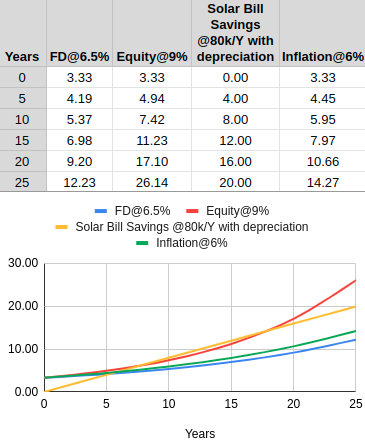
Based on the graph above and assuming no major maintenance costs throughout the lifetime of the rooftop solar plant investment in solar rooftop PV is clearly better than fixed deposits and even equity if subsidy/depreciation is available.
With the declining solar installation costs, this certainly becomes an attractive investment. My total system cost was bit higher due to a custom-built GI super-structure, therefore the ROI would greatly improve for deployments with a basic rooftop structure, and with subsidy or depreciation.
Some environmental stats for the 6.15kW solar plant (source: https://solarrooftop.gov.in/rooftop_calculator):
Carbon dioxide emissions mitigated is: 170 tonnes
Equivalent to planting: 272 Teak trees over the life time (data from IISc)
Future system expansion calculations for zero electricity bill: (not considering inflation, panel degradation)
Total Electricity Bill Outstanding = INR 120k-88k = INR 32k
Est. System Expansion for zero bill = INR 32k / (INR 8kWh * 4.5kWh * 365) = ~2.4kW
Est. Additional 410Wp Panels needed for zero bill = 2400 / 410 = ~6
Design
- An off-grid setup was found to be expensive due to high cost of (Lithum) batteries and would require more maintenance and could create concerns round running high-load requiring appliances such as ACs, geysers or water pumps.
- An on-grid system with net-metering was found to be most feasible in terms of ROI especially for urban deployments where powercuts are rare or infrequent.
- For on-grid systems, most discoms (power distributing companies) including DHBVN would install a net-meter that can track power imported/exported from/to the grid and allow consumers to take advantage of off-setting power consumed against power produced.
- Traditional on-grid systems have panels (that produce DC power) connected in series (string-based where voltages add up per panel, current flow is the same through panels) and typically has a one large DC-to-AC solar inverter that connects to the property and the grid. This design has problems such as many single points of failure, single inverter, shading issue (all panels operate at the level of the lowest performing panel).
- Modern on-grid systems can use micro-inverters where a small DC-to-AC micro-inverter is deployed for each solar panel that are connected in parallel keep the same voltage (say 220-240VAC) across panels that allow each panel to operate as an individual solar PV plant and therefore maximise generation.
Parts and Components
A typical rooftop solar plant essentially consists of:
- solar panel(s): device that converts sunlight to DC power.
- invertor(s): device that converts DC power from solar panels to AC.
- balance of system: consists of wiring, ACDB (AC power distribution box that can connect to the grid), circuit breakers (MCB, MCCBs), thimble/connectors, etc.
- batteries: (optional) to store excess generation, could be considered if netmeters and on-grid connection is not possible.

Typical Enphase based Rooftop Solar Plant layout (source)
#1 Solar Panels
Solar panels generally degrade over time, most manufactures guarantee 80% rated wattage over 25years. That means, a 100W panel is rated to output 80W in 25years time. IQ7+ peak output (AC) is documented as 295VA or 295W (at 1.0 power factor). An Enphase whitepaper recommended DC-AC ratio of 1.1-1.2, therefore the system requires a panel with at least 350W peak power rating.
After survey and consultation with Enphase sales team, Hiku-410Wp solar PV panels were chosen. These panels have 10-12years warranty and 80% power performance warranty for 25years, and unlike traditional solar panels they have half-cut cells that reduces resistive power-losses and have higher shade tolerance. I found the industry trend towards quarter-cut cells that may further reduce resistive losses.

Hiku 410Wp Panel
#2 Micro-Inverters
Traditional solar inverters are string based where solar panels are connected in series (they add voltages) and come with their own bag of issues.
After some survey and reading, I decided to go with Enphase IQ7+ microinverters.
- Microinverters are installed on every panel and can provide features such as per-panel monitoring, and optimise power output on per-panel basis.
- They are more reliable (upto 25yrs warranty) and remove a SPOF and provide ability to maintain/service/replace on per-panel basis.
- More safe, connected in parallel and reduces DC losses.
- A microinverter-based solar plant system would also allow mixing panels of different wattages as each panel-microinverter operates as an individual power plant.
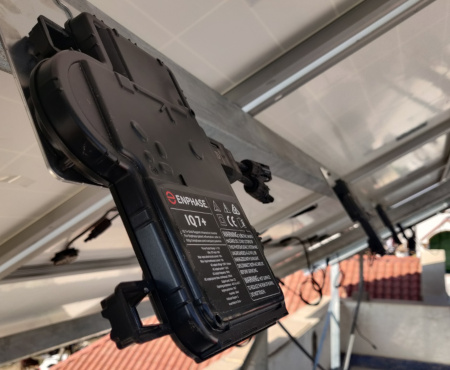
Enphase IQ7+ Microinverter
Installer
Finding a good installer who can do EPC (engineering, procurement and construction) is quintessential. I initially consulted many solar installers, compared their solution and quotation to determine the best price-solution fit.
Finally, with Enphase sales team’s consultation I went with one of their official channel partners: SunSon Energy.
Implementation
Sunson installed a raised GI (galvanized-iron, so structure does not rust) structure on my roof with concrete based footing. On this GI structure (as seen in the photograph below) 15 Hiku 410Wp panels were mounted and 15 Enphase IQ7+ microinverters were installed. The 15 panel-microinverter units were wired into three AC strings having 5 units of panel-microinverter each. Each panel-microinverter unit works as an independent solar plant and on each unit itself the microinverter converts DC power from solar panels to AC.

Each of the three AC-strings from the units were connected to a busbar junction box and then the solar-AC cables were fed to the three AC cables from the grid (with all the surge protection devices, MCBs etc).
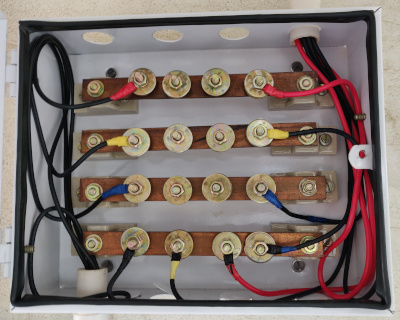
Busbar Junction Box
This central busbar junction box will allow extending the system in future without requiring any changes to the balance-of-system.
Production and Monitoring
The brain of the system is a gateway Linux-based IoT device called Enphase Envoy that monitors and communicates with the microinverters and tracks the total power consumption and production in real-time. Envoy periodically reports the stats to Enphase servers (typically every 5mins).
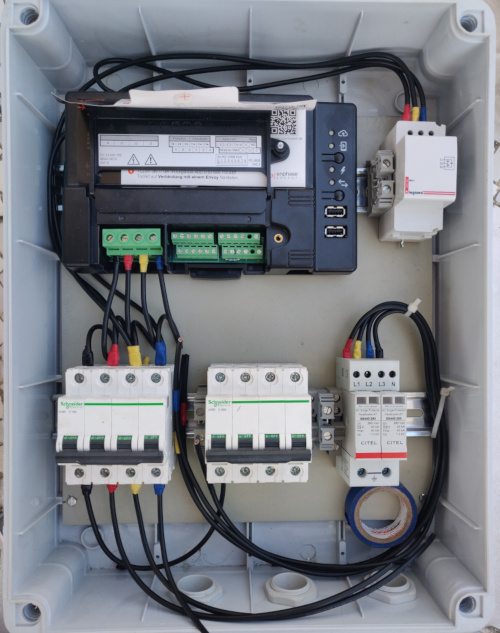
Enphase Envoy in AC Distribution Box (before deploying)
Sunson helped configure and setup an account for me, and now I can monitor the system power production, consumption using Enphase Enlighten:

Generation on a clear sunny day
Observing last 30 days (Feb-March), the average power production was at least ~4.5kWh per DC-kW (range of 3kWh to 5.6kWh per DC-kW depending on weather conditions).
The Enphase system also provides a software based kill-switch to stop production that can be done via the local Envoy connection or by the installer. It also allows to configure custom power profiles to say (a) not export to the grid, (b) export to the grid.
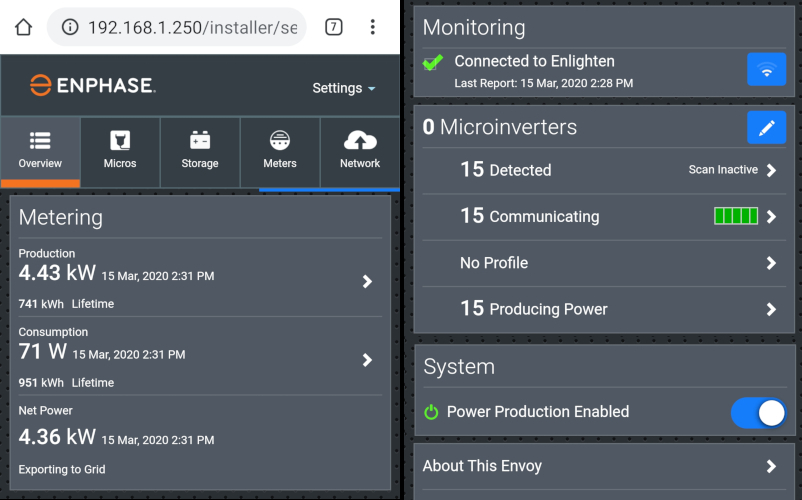
Envoy Installer Page
Safety
- During a grid-powercut, the Enphase system will stop production and not export any electricity to the grid.
- Microinverters connected in parallel ensure that voltages are limited (240VAC).
- Circuit breakers, surge protectors and MCCB ensure all parts of the systems can be isolated, shutdown or be tripped in case of a fault.
- The system has three separate ground wires (1) for the structure, (2) for the components (panels and microinverters) and (3) for a lightning conductor.
- The heavy ground-mounts (footings) and wind-gaps ensure stability to the structure.
Maintenance
The system has no moving parts and under normal circumstances would only require cleaning the panels every few weeks. In a rough experiment over three weeks, I found that unclean panels generate about 4-8% less electricity over cleaner ones and it depends on weather as well particulate matter in the air. Cleaning the panels every two weeks have yielded satisfactory results so far.

Timeline
Early 2019: Research and Survey
18 Dec 2019: IQ7+ availability confirmed
01 Jan 2020: EPC proposal received
06 Jan 2020: EPC contract signed
18 Jan 2020: GI structure mounted, civil work in progress
19 Jan 2020: Panels deployed
25 Jan 2020: Microinverters installed, civil work completed
28 Jan 2020: BoS installed, system (no-export) tested
20 Feb 2020: Net meter installed, system export on
08 Mar 2020: High record - 5.5kWh per system/DC kW tested
30 Jun 2020: Between March-June 2020, it produced 3.4MWh or ~4.58kWh per system kW per day
27 Sep 2021: Added 10 mono-perc panels with IQ7A (total plant capacity of 10kW)
Conclusion
After deploying the system and observing it since January I’m satisfied with the results so far. The daily production and ROI analysis show that the solar rooftop investment would beat fixed deposits (post-taxes), save electricity bills and promotes clean energy that would benefit the environment in the long run.
If you’re interested in deploying a rooftop solar plant for your home and commercial property you can contact a local solar installer who would be able to answer region specific questions and processes (as every power distribution company have their own policies).
If you want to explore microinverter based rooftop solar plant similar to my own deployment, you may contact:
- Enphase India by phone or email: https://enphase.com/en-in/contact-us-india
- Find an Enphase Partner Installer: https://enphase.com/en-in/find-an-installer
- SunSon Energy for Delhi/NCR region: https://go.enphase.com/installer/sunson, gosolar@sunsonenergy.com
Hope this post will encourage others to consider solar rooftop for their needs and promote clean renewable energy.
Acknowledgements
- Enphase (Sales: Rohit)
- Sunson Energy (Arshi and team - Feroz, Fateh, Mahendar)
- Thanks to Pushkal, Amar, Abhishek, Himadri, and Paras for reviewing this post.
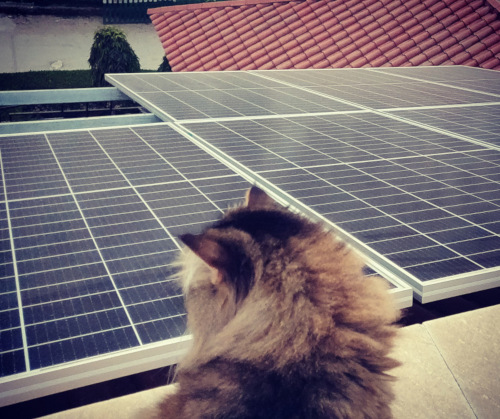
Gracie wonders - how these unclean panels generate clean energy!